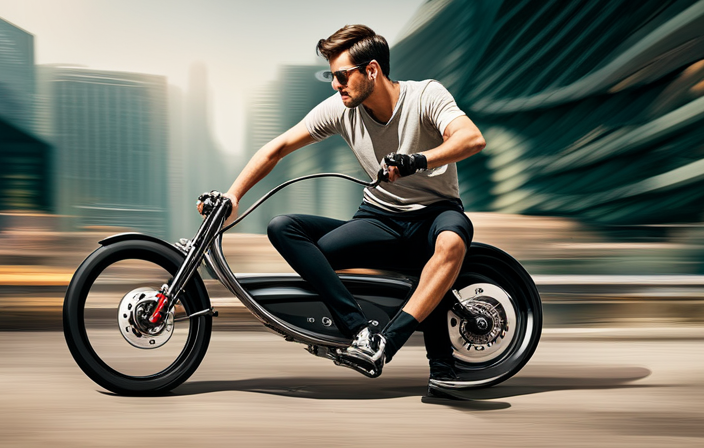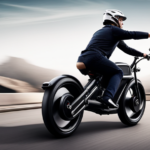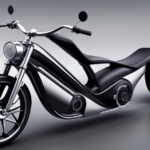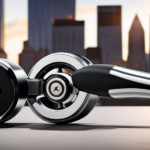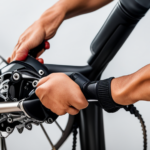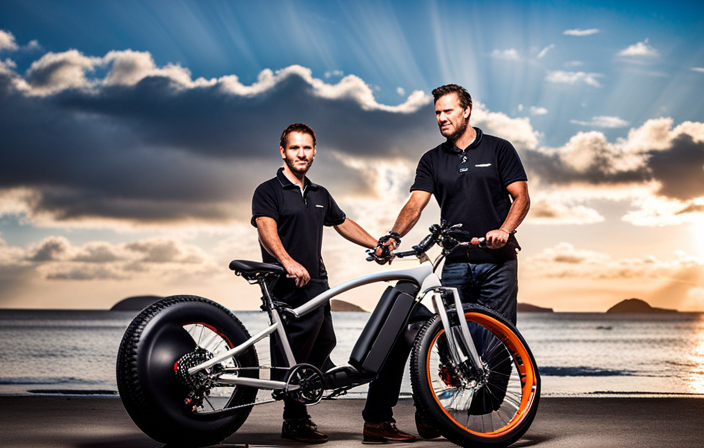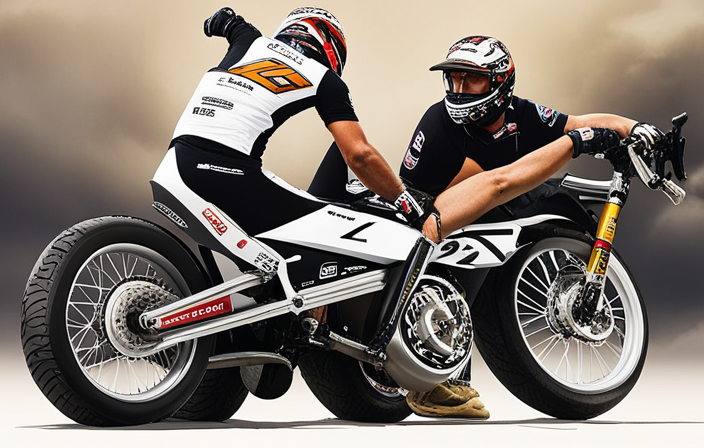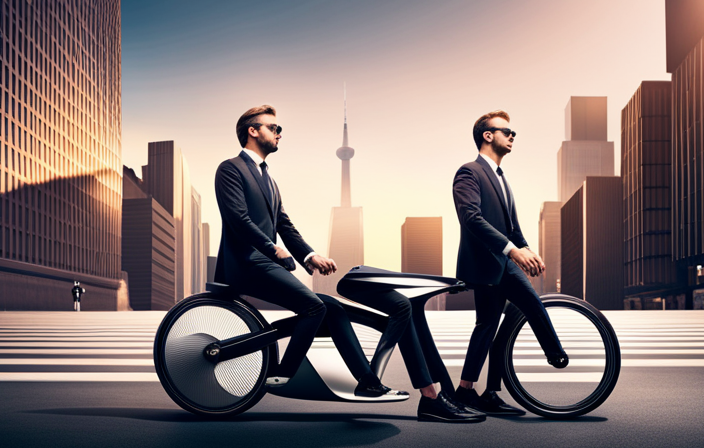I’ve always been fascinated by the inner workings of electric bikes, especially their throttle systems.
Did you know that electric bike throttle technology has come a long way in recent years? In fact, did you know that there are different types of electric bike throttles available?
In this article, I’ll explain how electric bike throttles work, the various types you can choose from, and provide tips for using and maintaining your throttle.
Let’s dive into the world of electric bike throttles and explore this exciting technology together.
Key Takeaways
- Electric bike throttles control the speed of the bike and provide instant power delivery.
- Throttles can be operated with the thumb, index finger, or by twisting the handlebar grip.
- Regular maintenance, including cleaning, lubrication, and checking for wear or damage, is important for smooth operation.
- Throttles offer precise speed control and benefit riders with limited mobility or disabilities.
Understanding the Basics of Electric Bikes
Electric bikes, also known as e-bikes, are becoming increasingly popular among commuters. One of the key components that make electric bikes so appealing is the electric bike throttle.
The throttle allows riders to control the speed of the e-bike effortlessly. It is a small device located on the handlebars that works similarly to a motorcycle throttle. Maintaining the electric bike throttle is relatively simple. Regular cleaning and lubrication of the throttle mechanism will ensure smooth operation. It is also important to check the throttle cable for any signs of wear or damage and replace it if necessary.
There are several advantages of electric bike throttles. Firstly, they provide instant power delivery. With a simple twist of the throttle, riders can accelerate quickly, making it easier to navigate through traffic or conquer hills. Secondly, the throttle allows riders to control their speed more precisely, giving them the freedom to ride at their desired pace. Additionally, the throttle can be a valuable asset for those with limited mobility or physical disabilities, as it reduces the effort required to pedal.
Understanding the basics of electric bikes and their components is essential to grasp how electric bike throttles function. By exploring the inner workings of the throttle, we can gain a deeper understanding of the role it plays in delivering power to the e-bike.
How Electric Bike Throttles Function
To operate the throttle on an electric bike, simply twist the handlebar grip towards you. The throttle is the control mechanism that regulates the power and speed of the electric motor. It is a crucial component in ensuring a smooth and controlled riding experience. Proper maintenance of the electric bike throttle is essential to ensure its optimal performance and longevity.
To assist you in understanding the functions and maintenance of an electric bike throttle, refer to the table below:
| Common Issues | Possible Causes |
|---|---|
| Throttle not responding | Loose or disconnected wiring |
| Inconsistent throttle response | Faulty throttle sensor |
| Stuck throttle | Dirt or debris in the throttle mechanism |
| Erratic power delivery | Malfunctioning controller |
When troubleshooting electric bike throttles, it is important to first check the wiring connections for any loose or disconnected wires. If the throttle is not responding, this is often the culprit. Inconsistent throttle response may indicate a faulty throttle sensor, which might require replacement. A stuck throttle can usually be resolved by cleaning the throttle mechanism to remove any dirt or debris. Lastly, if you experience erratic power delivery, it is likely due to a malfunctioning controller, which may need to be repaired or replaced.
Understanding the maintenance and troubleshooting of electric bike throttles is crucial for ensuring a smooth and reliable riding experience. Now, let’s explore the different types of electric bike throttles and their unique features.
The Different Types of Electric Bike Throttles
When exploring the different types of electric bike throttles, you’ll discover a variety of features that cater to different riding preferences. Here are some key points to consider:
-
Thumb throttles: These are positioned on the handlebars, allowing you to control the speed with your thumb. They provide a straightforward and intuitive method of accelerating and decelerating.
-
Trigger throttles: Similar to thumb throttles, trigger throttles are also located on the handlebars but are operated with your index finger. They offer precise control and are often preferred by riders who want a more responsive throttle.
-
Push-button throttles: Positioned within easy reach of your fingers, push-button throttles require a simple press to activate the motor. They are commonly found on electric bikes with pedal-assist systems.
-
Toggle throttles: These throttles consist of a small lever that can be flipped up or down to control the speed. They provide a tactile and ergonomic option for riders who prefer a different feel.
In addition to the different throttle positions, many electric bike throttles also offer throttle sensitivity adjustment. This feature allows you to customize the responsiveness of the throttle to better suit your riding style.
Transitioning into the subsequent section about twist throttles: how they work and their benefits, it’s important to understand the different types of throttles available.
Twist Throttles: How They Work and Their Benefits
If you’re considering a twist throttle, you’ll find that it operates by rotating the grip on the handlebars, providing a smooth and responsive way to control your electric bike’s speed. Twist throttles are a popular choice for electric bikes due to their numerous benefits.
One of the main advantages is their ease of use. With a simple twist of your wrist, you can increase or decrease the speed of your electric bike effortlessly. This intuitive control allows for a seamless riding experience, especially when maneuvering through traffic or navigating tricky terrains.
Another benefit of twist throttles is their precision. The rotational movement of the grip allows for precise control over the acceleration and deceleration of your electric bike. This means you can easily adjust your speed to match your riding conditions or preferences. Additionally, twist throttles provide a consistent and smooth throttle response, ensuring a comfortable and enjoyable ride.
However, it’s important to consider the disadvantages of twist throttles as well. One potential drawback is the possibility of accidental throttle activation. Since the twist throttle is directly connected to the handlebars, there is a chance of inadvertently applying throttle when turning or adjusting your grip. This can lead to sudden acceleration or loss of control, potentially causing accidents.
In the subsequent section, we will discuss thumb throttles, another popular choice for electric bikes, and examine their unique features and advantages.
Thumb Throttles: A Popular Choice for Electric Bikes
For precise control over your speed, thumb throttles offer a convenient and ergonomic option. Electric bike throttle maintenance is crucial to ensure smooth operation and longevity of your electric bike.
Thumb throttles are designed to be easily operated with just your thumb, allowing you to adjust your speed effortlessly. One of the advantages of thumb throttles is that they provide a natural and comfortable grip, reducing the strain on your wrist and hand. They are also highly responsive, allowing for precise control over your acceleration and deceleration.
To maintain your thumb throttle, regularly clean it with a mild detergent and warm water to remove any dirt or debris that may affect its performance. Additionally, lubricate the moving parts of the throttle to ensure smooth operation.
Now, let’s transition into the subsequent section about trigger throttles: a convenient option for riders.
Trigger Throttles: A Convenient Option for Riders
Trigger throttles, also known as twist throttles, provide a simple and intuitive way for riders to control their speed on electric bikes. The design of trigger throttles allows riders to easily adjust their speed by twisting the throttle grip with their hand. This convenient option eliminates the need for riders to remove their hand from the handlebars to control their speed, enhancing safety and control.
One of the benefits of trigger throttles is the precise control they offer. Riders can easily modulate their speed by adjusting the amount of twist applied to the throttle grip. This level of control allows riders to smoothly accelerate or decelerate as needed, whether they are navigating through traffic or climbing steep hills.
Another advantage of trigger throttles is their ergonomic design. The twist motion required to control the throttle is natural and comfortable for most riders. This design ensures that riders can maintain a firm grip on the handlebars while operating the throttle, enhancing stability and reducing the risk of accidents.
In the subsequent section about the role of the throttle in electric bike power assistance, we will explore how the throttle interacts with the motor to provide varying levels of power assistance.
The Role of the Throttle in Electric Bike Power Assistance
To control the level of power assistance on your electric bike, you simply twist the throttle grip. The throttle sensitivity determines how much power is delivered to the motor based on how far you twist the grip. This feature allows you to easily adjust the level of assistance according to your needs. The throttle sensitivity can be adjusted to be more or less sensitive, depending on your preference and riding style.
It is important to note that the throttle sensitivity can have an impact on battery life. When the throttle is set to be more sensitive, the motor will provide a higher level of power assistance, which can drain the battery faster. On the other hand, if the throttle sensitivity is set to be less sensitive, the motor will provide a lower level of power assistance, conserving the battery and extending the overall range of your electric bike.
Understanding the connection between the throttle and the motor is crucial for effectively controlling the power assistance on your electric bike. By manipulating the throttle, you are essentially regulating the flow of power from the battery to the motor, determining the speed and force at which your electric bike moves. This connection allows for a seamless and intuitive riding experience, putting you in control of your electric bike’s performance.
The Connection Between the Throttle and the Motor
In the previous subtopic, we discussed the crucial role of the throttle in providing power assistance to electric bikes.
Now, let’s delve deeper into the connection between the throttle and the motor, and how they communicate to deliver the desired power output.
When the throttle is engaged, it sends a signal to the motor controller, which interprets the input and determines the appropriate power level to send to the motor. This communication is vital for a seamless riding experience, as it ensures that the motor responds accurately to the rider’s input.
Moreover, the throttle also plays a significant role in managing battery life. By controlling the amount of power delivered to the motor, riders can regulate their usage, extending the battery’s lifespan.
For instance, a gentle twist of the throttle will provide less power and conserve energy, while a full twist will unleash maximum power output, resulting in faster acceleration and potentially draining the battery quicker.
Understanding the intricate connection between the throttle and the motor is essential for optimizing the performance and efficiency of an electric bike.
Now, let’s explore how the throttle controls speed and power output without further ado.
How the Throttle Controls Speed and Power Output
When you twist the throttle, you have direct control over the speed and power output of your electric bike. The throttle is a device that regulates the amount of power delivered to the motor based on your input. Power modulation is the ability to adjust the power output smoothly and precisely, and throttle sensitivity refers to how quickly the motor responds to changes in throttle input.
The throttle on an electric bike typically works by sending a signal to the motor controller, which then adjusts the power output accordingly. By twisting the throttle, you can increase or decrease the amount of power that is delivered to the motor, thus controlling the speed of your bike. The more you twist the throttle, the more power is sent to the motor, resulting in a faster speed.
Throttle sensitivity is an important factor in electric bike performance. A highly sensitive throttle will provide immediate response to small changes in input, allowing for precise control over speed and acceleration. On the other hand, a less sensitive throttle may require more input to achieve the desired power output.
In the next section, we will explore how throttles contribute to energy efficiency through regenerative braking, a feature that allows the motor to act as a generator and recharge the battery while slowing down the bike.
Regenerative Braking: How Throttles Contribute to Energy Efficiency
By utilizing regenerative braking, you can maximize energy efficiency and prolong the battery life of your electric bike. Regenerative braking is a feature that allows the electric bike to convert kinetic energy into electrical energy when the rider applies the brakes. This energy is then stored in the battery for later use, reducing the need to rely solely on external charging. Not only does regenerative braking contribute to energy efficiency, but it also helps to increase the overall range of the electric bike.
To better understand the impact of regenerative braking on energy efficiency, let’s take a look at the following table:
| Without Regenerative Braking | With Regenerative Braking | |
|---|---|---|
| Efficiency | Lower | Higher |
| Battery Life | Shorter | Longer |
| Throttle Response Time | Slower | Faster |
| Range | Limited | Extended |
As you can see, incorporating regenerative braking improves both efficiency and battery life. It also has the added benefit of enhancing throttle response time, allowing for quicker acceleration and better control. Additionally, regenerative braking extends the range of the electric bike, making it a valuable feature for those looking to go on longer rides.
Transitioning to the next section about safety considerations when using electric bike throttles, it is important to understand the potential risks and precautions associated with throttle usage.
Safety Considerations When Using Electric Bike Throttles
To ensure your safety while using the electric bike throttle, it’s important to be aware of the potential risks and take necessary precautions. Here are some safety considerations to keep in mind:
-
Maintain your electric bike throttle regularly to ensure its proper function and longevity. This includes inspecting for any loose or damaged parts and cleaning the throttle mechanism.
-
Always wear appropriate protective gear, such as a helmet and gloves, when operating your electric bike. This will help protect you in case of any accidents or falls.
-
Properly grip the electric bike throttle to maintain control and avoid accidental acceleration or deceleration. Make sure to keep your hand firmly on the throttle grip, with your fingers positioned comfortably around it.
-
Be mindful of your surroundings and adjust your speed accordingly. It’s important to stay vigilant and anticipate any potential hazards or obstacles on your path.
By following these safety considerations, you can enjoy a safer and more enjoyable electric bike riding experience.
Now, let’s move on to discuss some tips for properly using and maintaining your electric bike throttle.
Tips for Properly Using and Maintaining Your Electric Bike Throttle
To properly use and maintain your electric bike throttle, it’s crucial to regularly check for any loose or damaged parts and clean the throttle mechanism. Maintaining your electric bike throttle is essential to ensure its proper functioning and to avoid any potential issues while riding.
One important aspect of maintenance is to inspect the throttle regularly for loose or damaged parts. Check the screws and bolts that hold the throttle in place and make sure they are securely fastened. Additionally, examine the throttle cable for any signs of wear or damage. If any part is loose or damaged, it should be repaired or replaced immediately to prevent further problems.
Another important maintenance task is to clean the throttle mechanism regularly. Over time, dust, dirt, and debris can accumulate on the throttle, affecting its performance. Use a soft cloth or brush to gently remove any dirt or debris from the throttle and ensure smooth operation.
By properly maintaining your electric bike throttle, you can prolong its lifespan and enjoy a more reliable and efficient ride.
In the next section, we will discuss common issues and troubleshooting tips for throttles, which will help you address any problems that may arise.
Common Issues and Troubleshooting Tips for Throttles
One common issue with throttles is that they may not respond consistently, which can be frustrating for riders. This inconsistency can be caused by a variety of factors, such as loose connections or a faulty throttle sensor. To troubleshoot this problem, riders can start by checking all the wiring connections and ensuring they are tight and secure. If the connections are fine, the next step is to test the throttle sensor using a multimeter. This will help determine if the sensor is functioning properly or if it needs to be replaced.
Another common problem with throttles is that they may become sticky or unresponsive over time due to dirt or debris accumulation. In such cases, riders can try cleaning the throttle mechanism with a mild cleaner and a soft cloth. It is important to avoid using harsh chemicals or excessive force while cleaning to prevent damage to the throttle.
By following these troubleshooting techniques, riders can resolve common throttle issues and enjoy a smooth and responsive riding experience.
As technology advances, the future of electric bike throttle technology looks promising. Manufacturers are constantly working towards improving throttle responsiveness and reliability. In the coming years, we can expect to see more advanced throttle sensors that provide precise control over acceleration and speed. Additionally, there may be advancements in throttle designs to enhance ergonomics and user comfort.
With the increasing popularity of electric bikes, it is likely that throttle technology will continue to evolve to meet the needs of riders. The future of electric bike throttle technology holds great potential, offering riders an even better riding experience with improved performance and functionality.
The Future of Electric Bike Throttle Technology
If you’re an electric bike rider, you can look forward to exciting advancements in throttle technology in the future. The throttle is a key component that allows riders to control the speed and power of their electric bikes. Over the years, throttle technology has evolved to provide a smoother and more precise riding experience.
One of the major advancements in electric bike throttle technology is the integration of sensors and advanced algorithms. These sensors can detect the rider’s input and adjust the power output accordingly, resulting in a more intuitive and responsive riding experience. Additionally, advanced algorithms can optimize power delivery based on factors such as terrain, rider weight, and battery life, further enhancing the overall performance of electric bikes.
To illustrate the impact of throttle technology on electric bike performance, let’s take a look at the following table:
| Throttle Technology | Benefits | Impact on Electric Bike Performance |
|---|---|---|
| Sensor-based throttle | Intuitive and responsive control | Smoother acceleration and power delivery |
| Advanced algorithms | Optimized power output | Enhanced performance on various terrains |
| Adjustable sensitivity | Customizable riding experience | Fine-tuned control for different riding styles |
| Multi-mode throttle | Versatility in power delivery | Adaptability to different riding situations |
| Regenerative braking | Energy efficiency | Increased range through energy recovery |
As electric bike throttle technology continues to advance, riders can expect improved performance, efficiency, and customization options. With these advancements, electric bikes will become even more enjoyable and versatile to ride.
Moving forward, let’s explore other ways to control electric bike speed and power, expanding beyond throttle technology.
Exploring Other Ways to Control Electric Bike Speed and Power
As a rider, you can explore alternative methods for controlling the speed and power of your electric bike. While the throttle is the most common way to control an electric bike, there are other options available to you.
One alternative control method is the use of a pedal-assist system, also known as PAS. This system uses sensors to detect your pedaling motion and provides assistance based on your input. By adjusting the level of assistance, you can easily control the speed and power of your electric bike.
Using alternative control methods can have a positive impact on your electric bike’s battery life. The throttle, when used excessively, can drain the battery faster. This is because the throttle allows you to use the full power of the motor without any input from your pedaling.
On the other hand, a pedal-assist system encourages you to pedal, making the battery last longer. By relying more on your own pedaling power and using the electric motor as a supplement, you can extend the range of your electric bike.
In conclusion, exploring alternative control methods such as a pedal-assist system can provide you with more control over the speed and power of your electric bike. Not only does this offer a different riding experience, but it can also have a positive impact on your battery life.
Frequently Asked Questions
Can an electric bike throttle be installed on any type of electric bike?
Yes, an electric bike throttle can typically be installed on any type of electric bike. The installation process may vary depending on the specific bike model, but the benefits of using a throttle include easy acceleration and control over the speed of the bike.
Are there any legal restrictions on the use of electric bike throttles?
Legal requirements and potential risks must be considered when using electric bike throttles. Compliance with local regulations is necessary to avoid penalties. Throttles provide control over motor speed, enhancing the riding experience.
Can the throttle be used to control the speed of the electric bike?
Using the throttle to control the speed of an electric bike has pros and cons. It provides instant acceleration but may drain the battery faster. Using it excessively can decrease battery life.
Is it possible to retrofit a traditional bicycle with an electric bike throttle?
Yes, it is possible to retrofit a traditional bicycle with an electric bike throttle. The retrofitting process involves installing the throttle mechanism and connecting it to the electric motor. However, the cost implications of this process may vary depending on the specific components and labor involved.
Are there any safety concerns associated with using an electric bike throttle?
There are safety considerations associated with using an electric bike throttle, as it can increase the potential for accidents. It is important to be cautious and aware of the throttle’s responsiveness to prevent any mishaps while riding.
Conclusion
In conclusion, the electric bike throttle is a crucial component that allows riders to control their speed and power with ease. Whether it’s a twist throttle or a thumb throttle, understanding how they work and properly maintaining them is essential for a smooth and enjoyable ride.
As technology continues to advance, we can only wonder what the future holds for electric bike throttle technology. Will we see more innovative ways to control speed and power? Only time will tell.
